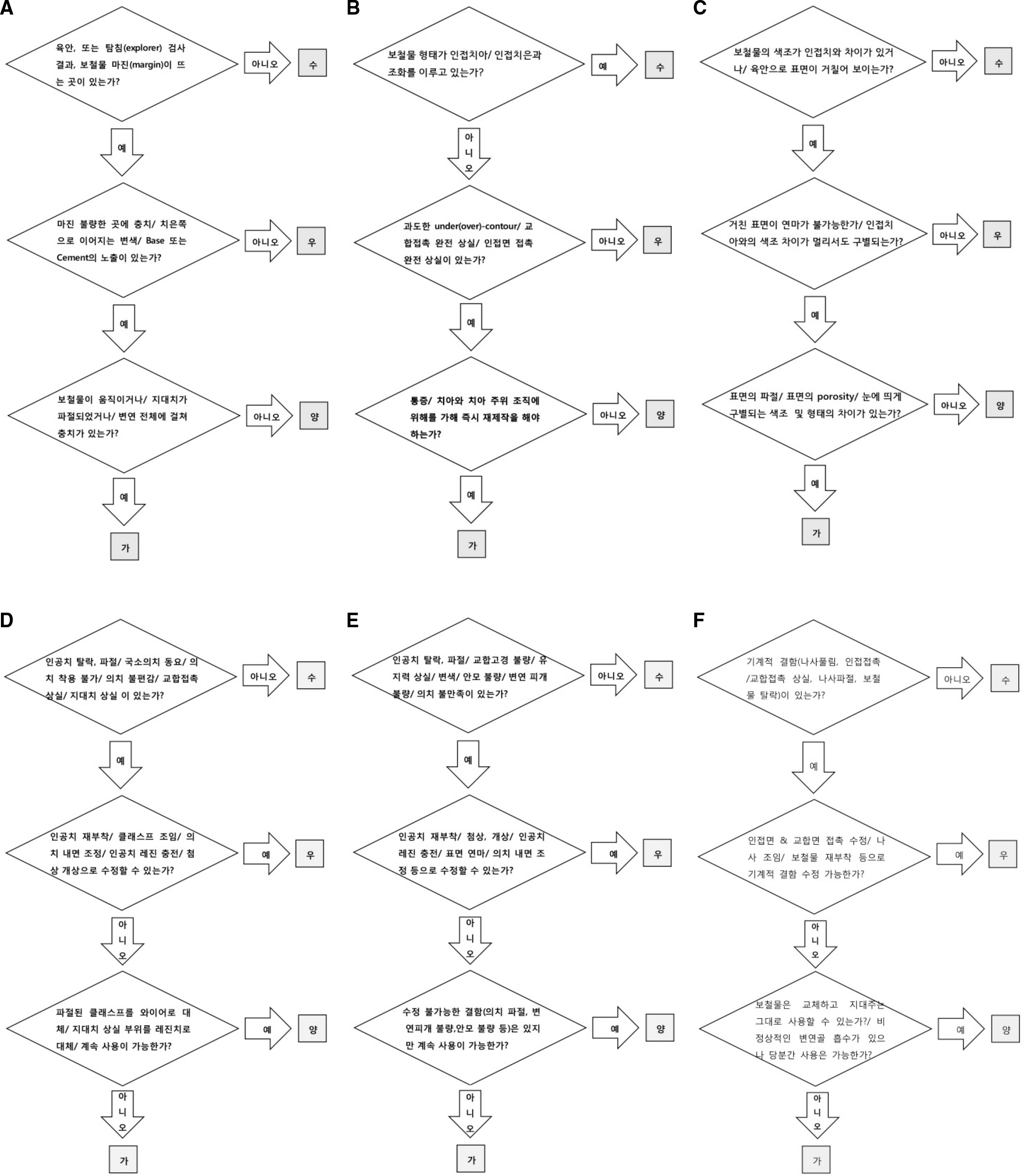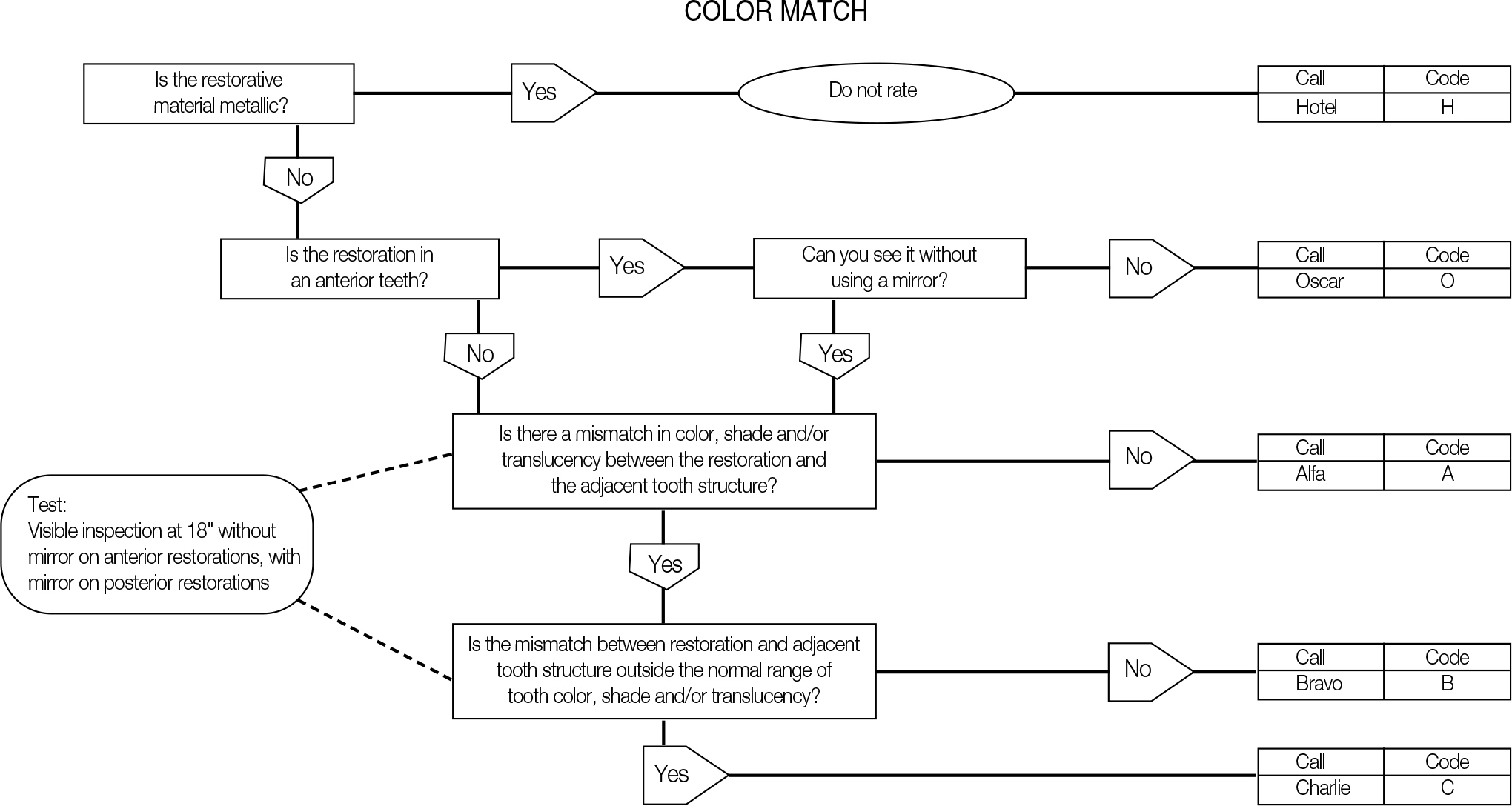J Korean Acad Prosthodont.
2016 Oct;54(4):341-353. 10.4047/jkap.2016.54.4.341.
Korea Academy of Prosthodontics criteria for longevity studies of dental prostheses
- Affiliations
-
- 1Department of Prosthodontics, School of Dentistry, NHIS Ilsan Hospital, Goyang, Republic of Korea.
- 2Department of Prosthodontics, School of Dentistry, Yonsei University, Seoul, Republic of Korea.
- 3Department of Prosthodontics, Yonsei Mate Dental Clinic, Seoul, Republic of Korea.
- 4Department of Prosthodontics, School of Medicine, Inha University, Incheon, Republic of Korea. onsdo@inha.ac.kr
- KMID: 2388212
- DOI: http://doi.org/10.4047/jkap.2016.54.4.341
Abstract
- PURPOSE
The most important factor in longevity studies of dental prostheses is objective and consistent evaluation of the prosthesis. The Korean Academy of Prosthodontics suggested developing a standardized method for longevity studies of dental prostheses. The purpose of this study is to evaluate previously-used criteria and to develop new criteria, in the form of a procedure flowchart and an evaluation sheet. These new criteria may be able to provide a unified standard for future longevity studies of dental prostheses.
MATERIALS AND METHODS
A literature review was performed about the evaluation of dental prostheses. Taking into account the strengths and weaknesses of previously used criteria, a novel, intuitive and objective method was developed for assessment of dental prostheses. Then, a pilot survey was performed with the newly developed flowchart and evaluation sheet to determine problems and implement possible improvements.
RESULTS
Thirty cases of fixed dental prosthesis (FDP), 25 cases of removable dental prosthesis (RDP), and 13 cases of implant supported prosthesis (ISP) were evaluated. The average life expectancy estimate was 12.82 years for FDP, 5.96 years for RDP, and 4.82 years for ISP with Kaplan-Meier survival analysis. Additionally, possible improvements discovered by the pilot survey were reflected in the flowchart and evaluation sheet.
CONCLUSION
The newly developed KAP criteria, flowchart and evaluation sheet enabled objective and consistent results in trial longevity studies of dental prostheses. It is expected that future studies will not only use the KAP criteria but also further improvement will be made on them.
Keyword
MeSH Terms
Figure
Cited by 2 articles
-
Analysis of longevity and success rate of fixed, removable, and implant prostheses treated in Korea
Joon-Ho Yoon, Young-Bum Park, Nam-Sik Oh
J Korean Acad Prosthodont. 2018;56(2):95-104. doi: 10.4047/jkap.2018.56.2.95.Retrospective study on survival, success rate and complication of implant-supported fixed prosthesis according to the materials in the posterior area
Hyun-Seok Chae, Yuan-Kun Wang, Jung-Jin Lee, Kwang-Yeob Song, Jae-Min Seo
J Korean Acad Prosthodont. 2019;57(4):342-349. doi: 10.4047/jkap.2019.57.4.342.
Reference
-
1.Kwon BK., Ahn HJ., Kang JK., Kim JY., Choi JH. The jurisdictional precedent analysis of medical dispute in dental field. J Oral Med Pain. 2006. 31:283–96.2.Cha YR., Kwon JS., Choi JH., Kim JY. The analysis of the current status of medical accidents and disputes researched in the Korean web sites. J Oral Med Pain. 2006. 31:297–316.3.Schwartz NL., Whitsett LD., Berry TG., Stewart JL. Unserviceable crowns and fixed partial dentures: life-span and causes for loss of serviceability. J Am Dent Assoc. 1970. 81:1395–401.
Article4.Walton JN., Gardner FM., Agar JR. A survey of crown and fixed partial denture failures: length of service and reasons for replacement. J Prosthet Dent. 1986. 56:416–21.
Article5.Glantz PO., Nilner K., Jendresen MD., Sundberg H. Quality of fixed prosthodontics after 15 years. Acta Odontol Scand. 1993. 51:247–52.
Article6.Glantz PO., Nilner K., Jendresen MD., Sundberg H. Quality of fixed prosthodontics after twenty-two years. Acta Odontol Scand. 2002. 60:213–8.
Article7.Holm C., Tidehag P., Tillberg A., Molin M. Longevity and quality of FPDs: a retrospective study of restorations 30, 20, and 10 years after insertion. Int J Prosthodont. 2003. 16:283–9.8.Hämmerle CH., Ungerer MC., Fantoni PC., Brägger U., Bürgin W., Lang NP. Long-term analysis of biologic and technical aspects of fixed partial dentures with cantilevers. Int J Prosthodont. 2000. 13:409–15.9.Lindquist E., Karlsson S. Success rate and failures for fixed partial dentures after 20 years of service: Part I. Int J Prosthodont. 1998. 11:133–8.10.Sundh B., Odman P. A study of fixed prosthodontics performed at a university clinic 18 years after insertion. Int J Prosthodont. 1997. 10:513–9.11.Libby G., Arcuri MR., LaVelle WE., Hebl L. Longevity of fixed partial dentures. J Prosthet Dent. 1997. 78:127–31.
Article12.Leempoel PJ., Käyser AF., Van Rossum GM., De Haan AF. The survival rate of bridges. A study of 1674 bridges in 40 Dutch general practices. J Oral Rehabil. 1995. 22:327–30.
Article13.Palmqvist S., Swartz B. Artificial crowns and fixed partial dentures 18 to 23 years after placement. Int J Prosthodont. 1993. 6:279–85.14.Valderhaug J. A 15-year clinical evaluation of fixed prosthodontics. Acta Odontol Scand. 1991. 49:35–40.
Article15.Karlsson S. A clinical evaluation of fixed bridges, 10 years following insertion. J Oral Rehabil. 1986. 13:423–32.
Article16.Pjetursson BE., Tan K., Lang NP., Brägger U., Egger M., Zwahlen M. A systematic review of the survival and complication rates of fixed partial dentures (FPDs) after an observation period of at least 5 years. Clin Oral Implants Res. 2004. 15:667–76.17.Scurria MS., Bader JD., Shugars DA. Meta-analysis of fixed partial denture survival: prostheses and abutments. J Prosthet Dent. 1998. 79:459–64.
Article18.Creugers NH., Käyser AF., van't Hof MA. A meta-analysis of durability data on conventional fixed bridges. Community Dent Oral Epidemiol. 1994. 22:448–52.
Article19.Shin WJ., Jeon YS., Lee KW., Lee HY., Han DH. Longevity and failure analysis of fixed restorations serviced in Korea. J Korean Acad Prosthodont. 2005. 43:158–75.20.Yun MJ., Jeon YC., Jeong CM. Evaluation of clinical status of fixed prosthesis. J Korean Acad Prosthodont. 2009. 47:99–107.
Article21.Cvar J., Ryge G. Criteria for the clinical evaluation of dental restorative materials. In: Documents UD ed. Printing Office, San Francisco USPHS 790244,. 1971. 1–42.22.California Dental Association. Guidelines for the assessment of clinical quality and professional performance. 3rd ed.Sacramento, CA: California Dental Association;1995.23.Vermeulen AH., Keltjens HM., van't Hof MA., Kayser AF. Ten-year evaluation of removable partial dentures: survival rates based on retreatment, not wearing and replacement. J Prosthet Dent. 1996. 76:267–72.
Article
- Full Text Links
- Actions
-
Cited
- CITED
-
- Close
- Share
- Similar articles
-
- Analysis of longevity and success rate of fixed, removable, and implant prostheses treated in Korea
- Evaluation of clinical status of fixed prosthesis
- A stress analysis of fixed prostheses with dental implant and natural tooth
- Comparison of the accuracy of digital impressions and traditional impressions: Systematic review
- Prediction of lifespan and assessing risk factors of large-sample implant prostheses: a multicenter study





